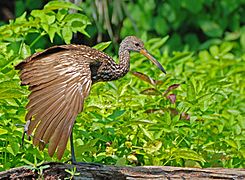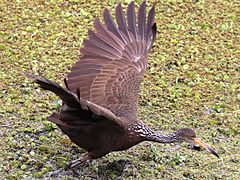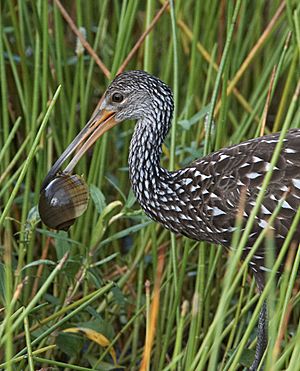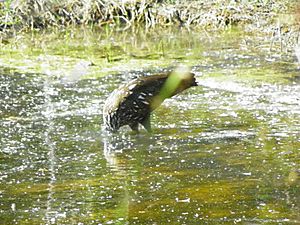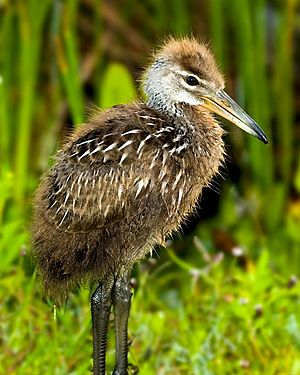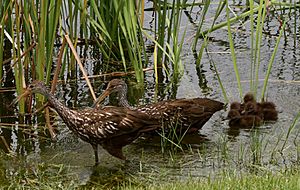Limpkin facts for kids
Quick facts for kids Limpkin |
|
|---|---|
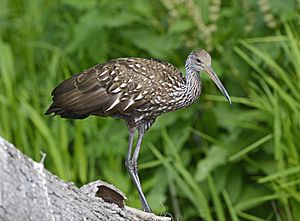 |
|
| A. guarauna, St. John's River, Florida | |
| Conservation status | |
| Scientific classification | |
| Genus: |
Aramus
|
| Species: |
guarauna
|
 |
|
| Range of A. guarauna | |
| Synonyms | |
|
Scolopax guarauna Linnaeus, 1766 |
|
The limpkin (Aramus guarauna) is a large wading bird. It is also known as the carrao, courlan, or crying bird. This bird is the only living species in its family, Aramidae. Limpkins are found mostly in warm, wet areas of the Americas, from Florida to northern Argentina. They love to eat molluscs, especially apple snails. The bird's name comes from the way it walks, which looks a bit like it has a limp.
Contents
About the Limpkin
The limpkin is a unique bird. It belongs to its own special family, Aramidae. This family is part of a larger group called Gruiformes. This group also includes cranes and rails. Scientists have studied the limpkin's DNA. They found it is closely related to cranes.
Even though the limpkin is the only living species in its family today, scientists have found fossils of its ancient relatives. These fossils show that birds like the limpkin have lived in the Americas for millions of years.
What Does a Limpkin Look Like?
The limpkin is a fairly large bird. It is about 64 to 73 centimeters (25 to 29 inches) long. Its wings can spread out to 101 to 107 centimeters (40 to 42 inches). An adult limpkin usually weighs between 900 and 1300 grams (2 to 2.9 pounds). Male limpkins are a little bigger than females. However, both sexes look the same.
Their feathers are dull brown with a slight olive shine. White marks cover their head, neck, and most of their body. This makes them look streaky. Their head and neck often appear light gray. Limpkins have long, dark-gray legs and a long neck. Their bill is long, heavy, and curves downwards. It is yellowish with a darker tip. The bill is slightly open at the end. This helps the bird grab snails like tweezers. The tip of the bill often curves a bit to the right. This matches the curve of an apple snail's shell. Young limpkins have fewer white markings.
You might hear a limpkin before you see it. They make a loud, wild wail or scream. It sounds like "kwEEEeeer" or "klAAAar." They often call at night, dawn, and dusk. They also make clicking sounds and short alarm calls.
Where Limpkins Live
Limpkins live in many places. You can find them from Florida in the United States, through Mexico, the Caribbean, and Central America. Their range extends all the way to northern Argentina in South America. They mostly live in marshes and swamps with fresh water. They also like areas with tall reeds and mangroves. In the Caribbean, they can even be found in dry brushland. In Florida, you will find limpkins wherever there are apple snails. This is because apple snails are their main food.
Limpkins sometimes move from one place to another. This is called migration. However, scientists do not fully understand how far they travel. In some northern areas, females might leave their breeding grounds in summer. They return in late winter. In Brazil, birds leave seasonal marshes during the dry season. They come back when the rains start. Some limpkins have been seen in the Florida Keys. This suggests they might fly between Florida and Cuba.
Limpkin Behavior and Life
Limpkins are active during the day and also at night. If people do not bother them, they can be quite calm and easy to approach. They usually stay near places where they can hide. They are not very aggressive birds. They usually do not fight with other birds or even with other limpkins.
Their long toes help them stand on floating water plants. They can also swim well, even as young chicks. However, they do not swim very often. They fly strongly with their neck stretched forward and legs backward. Their wings beat in a stiff, jerky way.
How Limpkins Find Food
Limpkins mostly look for food in shallow water. They also search on floating plants like water hyacinth. They walk slowly, looking for food in clear water. They might also probe the mud with their bills. They do not usually feed with other types of birds. However, they might forage in small groups with other limpkins.
Apple snails are the main food for limpkins. Where there are many apple snails, you will likely find limpkins. They also eat Freshwater mussels and other kinds of snails. Sometimes, they eat insects, frogs, lizards, crustaceans, and worms. These other foods are important when snails are hard to find.
When a limpkin catches an apple snail, it carries it to land or very shallow water. It places the snail in the mud with the opening facing up. Then, it cleverly removes the snail's "lid" (called an operculum). It pulls the snail out without breaking the shell. This takes only about 10 to 20 seconds. Limpkins often leave piles of empty snail shells in their favorite eating spots.
Reproduction and Life Cycle
Male limpkins have their own special areas, called territories. These areas can be small or large. In big swamps, many nests might be built close together. Males protect their territories strongly. They will fly to the edges to chase away other limpkins. Females also help protect the territory, usually from other females or young birds. Limpkins might keep their territory all year. Or they might leave it if food becomes scarce.
Limpkins can have one mate (monogamous). Or, one male might have two or more females (serially polyandrous). Studies show that only a few pairs stay together for the next year.
Limpkins build their nests in many different places. They can be on the ground, in thick floating plants, in bushes, or in trees. The nests are big and made of rushes, sticks, or other materials. The male usually starts building the nest before he finds a mate. Females visit different territories before choosing a male to breed with. Males might fight off females at first. They might not accept young females as mates. It can take a few weeks for a pair to form a bond. As part of this bonding, the male will catch a snail and feed it to the female.
A female limpkin lays three to eight eggs. Five to seven eggs are common, with an average of 5.5 eggs. The eggs are about 6.0 by 4.4 centimeters (2.4 by 1.7 inches). Their color varies a lot. They can be gray-white, buff, or deep olive. They have light-brown and sometimes purplish-gray spots. The eggs are laid one each day. Both parents sit on the eggs during the day. Only the female sits on them at night. The male spends more time incubating during the day. He will leave the nest to chase away intruders. The female quickly returns to the eggs if this happens. The eggs hatch in about 27 days. All the eggs hatch within 24 hours of each other.
Young limpkins are covered in soft down when they hatch. They can walk, run, and swim right away. They follow their parents to a platform of water plants. There, the parents keep them warm. Both parents feed the chicks. The young birds reach adult size at 7 weeks old. They leave their parents when they are about 16 weeks old.
Limpkin Challenges
Limpkins can be attacked by American alligators. Some adults have been seen with serious leg injuries. This suggests they might have been attacked by turtles while standing on floating plants. Snakes, raccoons, crows, and muskrats might eat their eggs in the nest. Sometimes, other birds try to steal snails from limpkins. For example, snail kites and boat-tailed grackles have been seen trying to take snails that limpkins have caught.
Scientists have also studied the parasites that live on or in limpkins. These include tiny worms and biting lice. Some worms can infect apple snails first, and then the limpkins get infected when they eat the snails.
Limpkins and People
Many of the limpkin's names sound like its call. For example, it's called carau in Argentina and carrao in Venezuela. Other names refer to its call, like "lamenting bird." Or they refer to its walk, like "crippled bird."
Limpkins do not appear much in old stories. However, in the Amazon, people believe that when the limpkin calls, the river will not rise any more. The limpkin's call has been used in movies. You might have heard it as a jungle sound effect in Tarzan films. It was also used for the hippogriff in the movie Harry Potter and the Prisoner of Azkaban.
Images for kids
See also
 In Spanish: Carrao para niños
In Spanish: Carrao para niños




